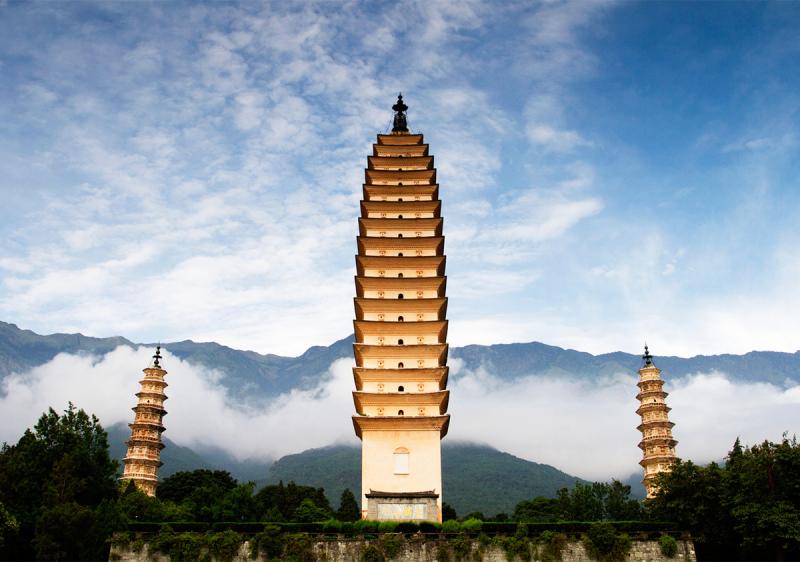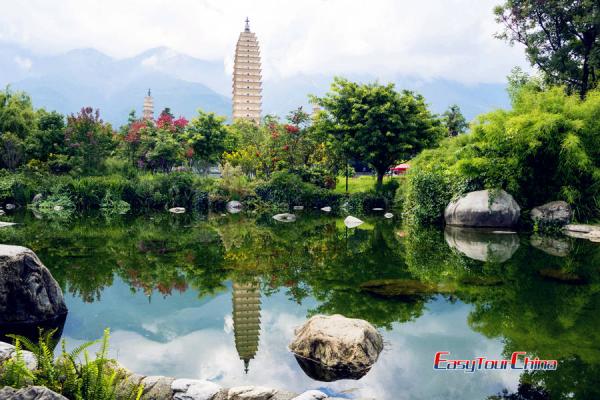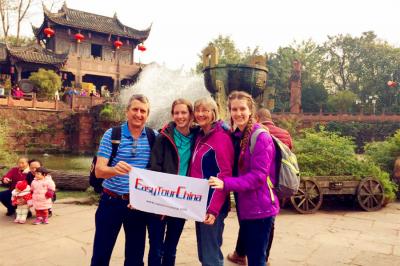Three Pagodas of Chongsheng Temple, Dali
1.5 kilometers northwest of Old Dali Town, the Three Pagodas of Chongsheng Temple are the oldest standing structures in Yunnan, and the iconic landmark of Dali. With Cangshan Mountain in the background, the majestic Three Pagodas stand on a hill and are visible from almost any vantage point within Dali and the surrounding area.
The tallest of the three, Qianxun Pagoda, has 16 tiers that reach a height of 69.13 meters. It was first built in the period 824 - 839 in the Tang Dynasty. It is flanked by two smaller 10-tierd pagodas, which are 42.19 meters each. The two small pagodas are 97 meters apart and each is 42.19 meters high. They are a pair of 10-story octagonal brick towers with multiple tiers.
In 1978, a renovation project was launched. 618 pieces of valuable antiques were found in the Three Pagodas of Dali, including Buddhist scriptures, statues, musical instruments and copper mirrors of Tang and Song Dynasties.
As a masterpiece of Chinese brick and stone architecture, and serves as a witness to the history of the Nanzhao and Dali Kingdoms, the Three Pagodas is one of the must-sees when you travel to Dali on your Yunnan tour.

Dali Three Pagodas Facts
History of Dali Three Pagodas - Why & How It Was Built
The Three Pagodas of Chongsheng Temple stand majestically. The central tower, known as the Qianxun Pagoda, was built during the Nanzhao Kingdom period of the Tang Dynasty (833–840 AD). The two smaller towers to the north and south were constructed during the reigns of Duan Zhengyan and Duan Zhengxing of the Dali Kingdom in the Song Dynasty (1108–1172 AD).
Beyond the Buddhist aspiration for enlightenment, a crucial reason for constructing the three pagodas was Dali's ancient vulnerability as a “land of lakes prone to flooding.” Legend recounts that during construction, layers of earth were added one by one as the pagodas rose. Only after completion were these layers excavated to reveal the towers, giving rise to the sayings “piling earth to build pagodas” and “excavating earth to reveal pagodas.”
The bridge constructed for the towers was as high as a hill and stretched over ten li (approximately 5 kilometers). When labor and resources proved insufficient, goats were even used to carry bricks. The present-day village of Yinqiao in Dali was historically known as “Tower Bridge Village.” Ancient records document the construction of the Three Pagodas as requiring “seven million seven hundred thousand laborers, consuming over forty thousand taels of gold, and taking eight years to complete.” Following the pagodas, the grand Chongsheng Temple was erected.
According to historical records such as the Wild History of Nanzhao and the Comprehensive Records of the Bai People, when Chongsheng Temple and the main pagodas were built, the temple grounds covered an area of seven li. The venerable monk Li Chengmei constructed the three pagodas, housing 890 structures, 11,400 Buddha statues, 40,590 jin of bronze, over 708,000 laborers, and consumed gold, silver, cloth, silk, satin, and brocade valued at 43,514 jin of gold.
In the ninth year of the Zhengde reign of the Ming Dynasty (1514 AD), a major earthquake struck. The Qianxun Pagoda “split open by about two feet, resembling a split bamboo stalk,” but later “reunited within ten days.”

The Architecture of Three Pagodas
Qianxun Pagoda
The Qianxun Pagoda has a square base measuring 9.85 meters on each side. It is a square, multi-eaved, hollow-brick pagoda with 16 tiers, standing at an actual height of 69.13 meters. A wooden staircase spirals upward within the tower's core. The tower body exhibits a spindle shape with rounded lines, characteristic of typical Tang Dynasty architectural style. In ancient times, “xun” was a unit of height measurement, with one xun equaling eight chi. “Qianxun” thus describes the tower's immense height. Alongside the Small Wild Goose Pagoda in Xi'an, it stands as a representative surviving example of Tang Dynasty multi-eaved pagodas.
The first level serves as the base, standing over thirteen meters tall—more than one-fifth of the tower's total height—exemplifying the typical high-base construction method. The base is entirely brick-built, with walls approximately 3.3 meters thick, while the hollow interior also measures about 3.3 meters. From the second level upward, niches or window openings are set into the central tower body. The dome roof begins at the fifteenth level.
The original spire was destroyed in the 1925 Dali earthquake. The present spire, restored in the late 1870s, consists of a central pillar, finial, canopy, wheel of dharma, and lotus pedestal. Two iron rods are fixed at the tower's four corners, which scholars speculate may be remnants of the original “golden phoenix” decoration.
The “Eternal Guardian of Mountains and Rivers” screen wall stands east of the Thousand-Foot Pagoda. Added during the Ming Dynasty, this stone-built wall features a marble panel in its eastern center, inscribed with the characters “永镇山川” (Eternal Guardian of Mountains and Rivers) written by Mu Shijie, a descendant of Mu, the Duke of Qian of the Ming Dynasty.
North and South Small Pagodas
The two small pagodas, positioned north and south, feature conical silhouettes characteristic of typical Song Dynasty architecture. Separated by 97 meters, each stands 42.19 meters tall. They are octagonal, ten-tiered brick pagodas with a pavilion-style design. Each tier features simulated wooden brackets, platforms, and uniquely shaped niches. The tower bodies are adorned with relief carvings of Buddhist statues, lotus flowers, vases, and other motifs, varying on each level.
Both small pagodas stand 70 meters from the main pagoda, forming an isosceles triangle with the central tower.
>> Recommended 3 Days Dali Old Town Tour with Xizhou & Zhoucheng
Main Buildings
Chongsheng Temple
Chongsheng Temple was the most magnificent monastery ever built in the Dali region. Initially Founded during the Nanzhao period, it became an imperial temple during the Dali Kingdom era. During the Xiannian years of the Qing Dynasty, the temple complex was destroyed in warfare, with only the Three Pagodas spared. The original temple's grandeur was documented in Xu Xiake's Travel Notes. The present Chongsheng Temple is a reconstruction in 2005.

Sea-Viewing Tower
The Sea-Viewing Tower stands as a significant structure behind Chongsheng Temple. This triple-eaved Ming-Qing style pavilion offers an exceptional vantage point. Ascending its heights reveals panoramic views of Dali, with Cangshan Mountain and Erhai Lake stretching before your eyes.
Rain-Copper Guanyin Hall
The Rain-Copper Guanyin was cast in the second year of the Nanzhao Dynasty's Zhongxing era (899 AD). Legend has it that when high monks were casting the statue, the copper ran out halfway through. Just as they despaired, a rain of copper fell from the sky, covering the ground with copper shavings. These were used to complete the statue, hence the name “Rain-Copper Guanyin.” Alongside the Three Pagodas and the Jianji Bell, the Rain-Copper Guanyin is one of the three most important treasures among the Five Great Treasures of Chongsheng Temple.
The current Rain-Copper Guanyin statue in the central hall is a meticulously crafted replica based on late Qing dynasty photographs, weighing 11 tons. Standing atop a 2.2-meter-high white marble Sumeru pedestal is an 1.8-meter-tall gilded copper lotus pedestal, upon which stands the 8.6-meter-tall gilded Rain-Copper Guanyin statue.
Hall of Eminent Monks
The Hall of Eminent Monks houses nine statues of kings from the Dali Kingdom who became monks, each standing 4 meters tall.
Ancestral Masters Hall
This hall venerates the Sixth Patriarch of Chan Buddhism. Chan Buddhism represents the most influential, widely disseminated, and distinctly Chinese Buddhist school in the history of Chinese Buddhism.
Great Hero Hall
The Great Hero Hall, towering and brightly illuminated with resplendent gold and vermilion, is modeled after the Hall of Supreme Harmony in the Forbidden City, Beijing. Featuring a double-eaved roof and nine bays, it spans 51.7 meters in width and 26 meters in height, making it the largest hall within any Chinese Buddhist monastery.
Cultural Relics in Three Pagodas and Chongsheng Temple
The Great Bell of Nanzhao's Jianji Era
The Great Bell of Nanzhao's Jianji Era, located behind the Three Pagodas, was originally one of the five major sacred objects of Chongsheng Temple. “Nanzhao” was the state name, while “Jianji” was the era name. Cast in the twelfth year of the Jianji era (871 AD) during the Nanzhao Kingdom, Xu Xiake described it in his Travels in Yunnan: The bell is immense, over ten feet in diameter and a foot thick, its sound audible eighty miles away."
Regrettably, the original bell was destroyed during the turmoil of the late Qing dynasty. The bell we see today was recast in 1997. Standing 3.86 meters tall with a diameter of 2.138 meters and weighing 16.295 tons, it is the largest bell in Yunnan Province.
Prayer Wheels and Vajra
Prayer wheels rotate freely on bearings at both ends, engraved with sutras and the Six-Syllable Mantra. Those at Chongsheng Temple bear inscriptions of the Sutra of Peace, the Heart Sutra, the Diamond Sutra, and the Lotus Sutra. The vajra, originally a weapon in ancient India, evolved into a Buddhist ritual implement symbolizing the severing of afflictions and subduing of demons after its introduction to Buddhism. The largest vajra at Chongsheng Temple measures 6 meters in length and 1 meter in diameter, earning it the title of “King of Vajras.”
>> Recommended China Yunnan tours to Dali Three Pagodas
Best Time to Visit the Three Pagodas of Chongsheng Temple
According to Dali weather, this ancient city enjoys spring-like conditions year-round from January to December, making the Three Pagodas of Chongsheng Temple a destination whether it is summer or winter.
How to Get to the Three Pagodas from Dali
By Foot
From Dali City Center to the Three Pagodas
More Attractions in Dali


